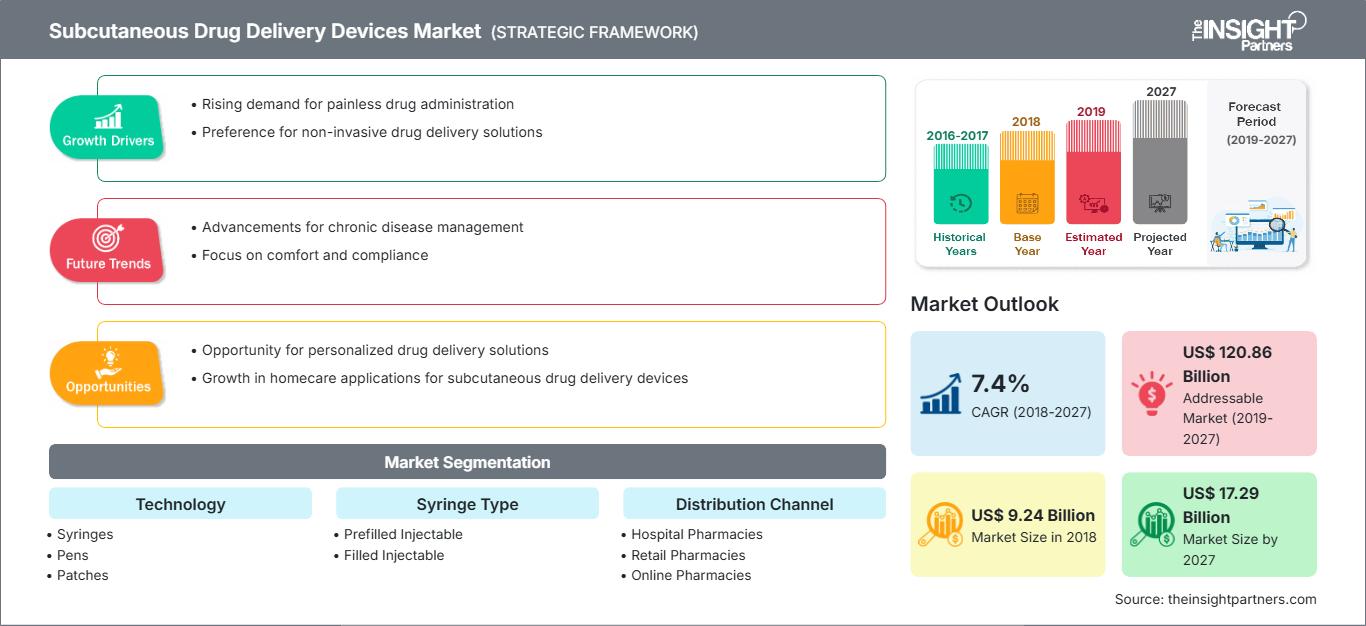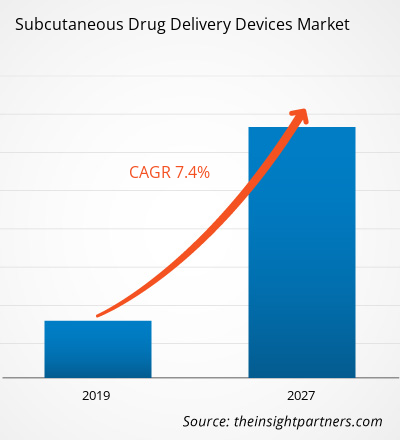Der Markt für Geräte zur subkutanen Arzneimittelverabreichung hatte im Jahr 2018 einen Wert von 9.243,80 Millionen US-Dollar und soll im Jahr 2027 voraussichtlich 17.290,47 Millionen US-Dollar erreichen; von 2019 bis 2027 wird ein CAGR-Wachstum von 7,4 % erwartet.
Die subkutane Arzneimittelverabreichung bezeichnet einen Prozess, bei dem Medikamente oder Arzneimittel unter die Haut verabreicht werden. Bei der subkutanen Arzneimittelverabreichung wird das Medikament mit einer kleinen Nadel in das Gewebe zwischen Muskel und Haut injiziert. Das Medikament wird normalerweise in geringen Mengen injiziert, die zwischen 1 ml und 2 ml variieren. Insulin wird beispielsweise häufig subkutan injiziert. Bauch, Arm und Oberschenkel sind die häufigsten Injektionsstellen für subkutane Injektionen. Das Wachstum des globalen Marktes für subkutane Arzneimittelverabreichungsgeräte ist auf die zunehmende Zahl chronischer Erkrankungen, steigende Forschungs- und Entwicklungsausgaben in Pharma- und Medizintechnikunternehmen sowie den technologischen Fortschritt und die zunehmende Anzahl neuer Produkteinführungen zurückzuführen. Das mit der Verwendung von Injektionen und Spritzen verbundene Infektions- und Krankheitsrisiko ist jedoch der Hauptfaktor, der das Marktwachstum hemmt.
Der globale Markt für subkutane Arzneimittelverabreichungsgeräte wird nach der Pandemie voraussichtlich ein deutliches Wachstum verzeichnen. COVID-19 hat die Wirtschaft und Industrie in verschiedenen Ländern durch Lockdowns, Reiseverbote und Geschäftsschließungen beeinträchtigt. Die COVID-19-Krise hat die öffentlichen Gesundheitssysteme in vielen Ländern überlastet und den dringenden Bedarf an nachhaltigen Investitionen in diese Systeme verdeutlicht. Mit fortschreitender COVID-19-Pandemie wird für die Gesundheitsbranche ein Wachstumsrückgang erwartet. Der Bereich Life Sciences floriert aufgrund der gestiegenen Nachfrage nach In-vitro-Diagnostika und der weltweit zunehmenden Forschungs- und Entwicklungsaktivitäten. Der Bereich Medizintechnik und Bildgebung verzeichnet jedoch Umsatzrückgänge aufgrund geringerer Operationen und verzögerter oder längerer Gerätebeschaffung. Darüber hinaus wird erwartet, dass virtuelle Konsultationen durch medizinisches Fachpersonal nach der Pandemie zum gängigen Versorgungsmodell werden. Da Telemedizin die Gesundheitsversorgung verändert, wird die digitale Gesundheit in den kommenden Jahren weiter florieren. Darüber hinaus dürften unterbrochene klinische Studien und die daraus resultierende Verzögerung bei der Markteinführung von Medikamenten den Weg für künftige vollständig virtuelle Studien ebnen. Neue Technologien wie mRNA werden voraussichtlich aufkommen und die Pharmaindustrie verändern, und es wird erwartet, dass der Markt in den kommenden Jahren mehr vertikale Integration und Joint Ventures erleben wird.
Passen Sie diesen Bericht Ihren Anforderungen an
Sie erhalten kostenlos Anpassungen an jedem Bericht, einschließlich Teilen dieses Berichts oder einer Analyse auf Länderebene, eines Excel-Datenpakets sowie tolle Angebote und Rabatte für Start-ups und Universitäten.
Markt für subkutane Arzneimittelverabreichungsgeräte: Strategische Einblicke

- Holen Sie sich die wichtigsten Markttrends aus diesem Bericht.Dieses KOSTENLOSE Beispiel umfasst Datenanalysen, die von Markttrends bis hin zu Schätzungen und Prognosen reichen.
Markteinblicke: Steigende F&E-Ausgaben bei Pharma- und Medizintechnikunternehmen treiben das Wachstum des globalen Marktes für subkutane Arzneimittelverabreichungsgeräte voran
Sie erhalten kostenlos Anpassungen an jedem Bericht, einschließlich Teilen dieses Berichts oder einer Analyse auf Länderebene, eines Excel-Datenpakets sowie tolle Angebote und Rabatte für Start-ups und Universitäten.
Markt für subkutane Arzneimittelverabreichungsgeräte: Strategische Einblicke

- Holen Sie sich die wichtigsten Markttrends aus diesem Bericht.Dieses KOSTENLOSE Beispiel umfasst Datenanalysen, die von Markttrends bis hin zu Schätzungen und Prognosen reichen.
Forschung und Entwicklung (F&E) ist ein wesentlicher und entscheidender Teil des Geschäfts der Unternehmen. Pharma- und Medizintechnikunternehmen konzentrieren sich auf Forschung und Entwicklung (F&E), um neue Moleküle für verschiedene therapeutische Anwendungen mit dem größten medizinischen und kommerziellen Potenzial zu entwickeln. Die Unternehmen investieren massiv in F&E mit dem Ziel, qualitativ hochwertige und innovative Produkte auf den Markt zu bringen.
Auch die F&E-Ausgaben der biopharmazeutischen Unternehmen sind im Laufe der Jahre gestiegen. Laut einem Bericht von Pharmaceutical Research and Manufacturers of America (PhRMA) sind die F&E-Ausgaben der Biopharmaunternehmen von 49,6 Milliarden US-Dollar im Jahr 2012 auf 58,8 Milliarden US-Dollar im Jahr 2015 gestiegen. Außerdem hat die Evonik Corporation in den letzten vier Jahren mehr als 50 Millionen US-Dollar investiert, um ihre Kompetenzen im Bereich medizinischer Geräte und der Produktion von RESOMER-Polymeren für die Arzneimittelverabreichung und biologisch resorbierbarer medizinischer Geräte auszubauen.
Die wachsenden F&E-Ausgaben treiben daher den Markt für subkutane Arzneimittelverabreichungssysteme im Prognosezeitraum an.
Technologiebasierte Erkenntnisse
Technologischer Hinsicht ist der globale Markt für subkutane Arzneimittelverabreichungssysteme in Spritzen, Pens, Pflaster und Sonstiges unterteilt. Im Jahr 2018 hatte das Spritzensegment den größten Marktanteil. Das Segment der Pflaster wird im Prognosezeitraum voraussichtlich am schnellsten wachsen.
Einblicke nach Spritzentypen
Der globale Markt für subkutane Arzneimittelverabreichungsgeräte ist nach Spritzentypen in vorgefüllte und befüllbare Spritzen unterteilt. Im Jahr 2018 hatte das Segment der befüllbaren Spritzen den größten Marktanteil. Im Prognosezeitraum wird jedoch erwartet, dass das Segment der vorgefüllten Spritzen die höchste durchschnittliche jährliche Wachstumsrate verzeichnet.
Subkutane ArzneimittelverabreichungsgeräteRegionale Einblicke in den Markt für subkutane Arzneimittelverabreichungsgeräte
Die Analysten von The Insight Partners haben die regionalen Trends und Faktoren, die den Markt für subkutane Arzneimittelverabreichungsgeräte im Prognosezeitraum beeinflussen, ausführlich erläutert. In diesem Abschnitt werden auch die Marktsegmente und die geografische Lage für subkutane Arzneimittelverabreichungsgeräte in Nordamerika, Europa, im asiatisch-pazifischen Raum, im Nahen Osten und Afrika sowie in Süd- und Mittelamerika erörtert.
Umfang des Marktberichts über Geräte zur subkutanen Arzneimittelverabreichung
| Berichtsattribut | Einzelheiten |
|---|---|
| Marktgröße in 2018 | US$ 9.24 Billion |
| Marktgröße nach 2027 | US$ 17.29 Billion |
| Globale CAGR (2018 - 2027) | 7.4% |
| Historische Daten | 2016-2017 |
| Prognosezeitraum | 2019-2027 |
| Abgedeckte Segmente |
By Technologie
|
| Abgedeckte Regionen und Länder | Nordamerika
|
| Marktführer und wichtige Unternehmensprofile |
|
Dichte der Marktteilnehmer für subkutane Arzneimittelverabreichungsgeräte: Verständnis ihrer Auswirkungen auf die Geschäftsdynamik
Der Markt für subkutane Arzneimittelverabreichungsgeräte wächst rasant. Die steigende Nachfrage der Endverbraucher ist auf Faktoren wie veränderte Verbraucherpräferenzen, technologische Fortschritte und ein stärkeres Bewusstsein für die Produktvorteile zurückzuführen. Mit der steigenden Nachfrage erweitern Unternehmen ihr Angebot, entwickeln Innovationen, um den Bedürfnissen der Verbraucher gerecht zu werden, und nutzen neue Trends, was das Marktwachstum weiter ankurbelt.

- Holen Sie sich die Markt für subkutane Arzneimittelverabreichungsgeräte Übersicht der wichtigsten Akteure
Der globale Markt für Geräte zur subkutanen Arzneimittelverabreichung ist nach Vertriebskanälen in Krankenhausapotheken, Einzelhandelsapotheken und Online-Apotheken unterteilt. Das Segment Krankenhausapotheken hatte 2018 den größten Marktanteil und wird im Prognosezeitraum voraussichtlich am schnellsten wachsen.
Die Akteure auf dem globalen Markt für Geräte zur subkutanen Arzneimittelverabreichung verfolgen Strategien zur Produkteinführung und -erweiterung, um den sich weltweit ändernden Kundenanforderungen gerecht zu werden und so ihren Markennamen weltweit zu behaupten.
Globaler Markt für Geräte zur subkutanen Arzneimittelverabreichung – nach Technologie
- Spritzen
- Pens
- Pflaster
- Sonstige
Globaler Markt für Geräte zur subkutanen Arzneimittelverabreichung – nach Spritzentyp
- Vorgefüllte Injektionsspritze
- Befüllbare Injektionsspritze
Globaler Markt für Geräte zur subkutanen Arzneimittelverabreichung – nach Vertriebskanal
- Einzelhandelsapotheken
- Krankenhausapotheken
- Online-Apotheken
Globaler Markt für Geräte zur subkutanen Arzneimittelverabreichung – nach Geografie
- Nordamerika
- USA
- Kanada
- Mexiko
- Europa
- Frankreich
- Deutschland
- Italien
- Vereinigtes Königreich
- Spanien
- Übriges Europa
- Asien-Pazifik (APAC)
- China
- Indien
- Südkorea
- Japan
- Australien
- Rest von APAC
- Naher Osten und Asien Afrika (MEA)
- Südafrika
- Saudi-Arabien
- VAE
- Rest von MEA
- Südamerika und Mittelamerika (SCAM)
- Brasilien
- Argentinien
- Rest von SCAM
Firmenprofile
- Insulet Corporation
- BD
- Enable Injections
- Consort Medical Plc
- West Pharmaceutical Services, Inc.
- Elcam Medical
- Amgen
- Ypsomed AG
- SCPharmaceuticals, Inc.
- Wilhelm Haselmeier GmbH & Co. KG
- Historische Analyse (2 Jahre), Basisjahr, Prognose (7 Jahre) mit CAGR
- PEST- und SWOT-Analyse
- Marktgröße Wert/Volumen – Global, Regional, Land
- Branchen- und Wettbewerbslandschaft
- Excel-Datensatz
Aktuelle Berichte
Verwandte Berichte
Erfahrungsberichte
Grund zum Kauf
- Fundierte Entscheidungsfindung
- Marktdynamik verstehen
- Wettbewerbsanalyse
- Kundeneinblicke
- Marktprognosen
- Risikominimierung
- Strategische Planung
- Investitionsbegründung
- Identifizierung neuer Märkte
- Verbesserung von Marketingstrategien
- Steigerung der Betriebseffizienz
- Anpassung an regulatorische Trends






















 Kostenlose Probe anfordern für - Markt für subkutane Arzneimittelverabreichungsgeräte
Kostenlose Probe anfordern für - Markt für subkutane Arzneimittelverabreichungsgeräte